What Would Be A Good Guitar Practice Routine?
- Paul Andrews
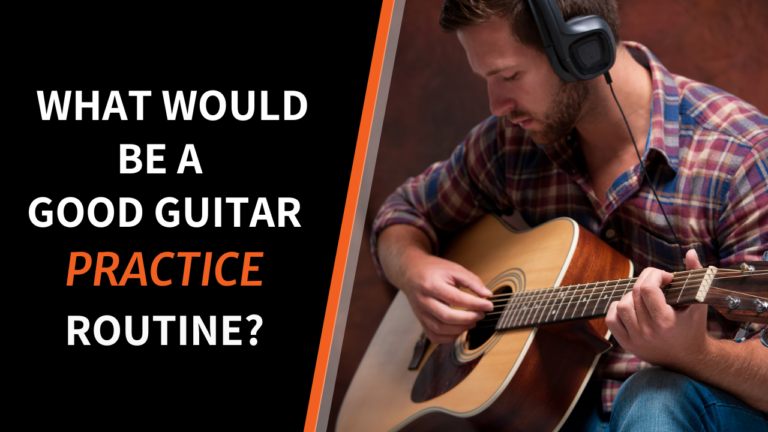
In this article I am going to answer the question ‘what would be a good guitar practice routine?’
I go through exactly what you should include in your practice routine, give you a 30, 20 & 10-minute routine to follow and deep dive into an example routine showing you how it all fits together.
After reading through you will have a clear plan on how to improve your practice sessions and make the most of your practice time.
What are your Goals?
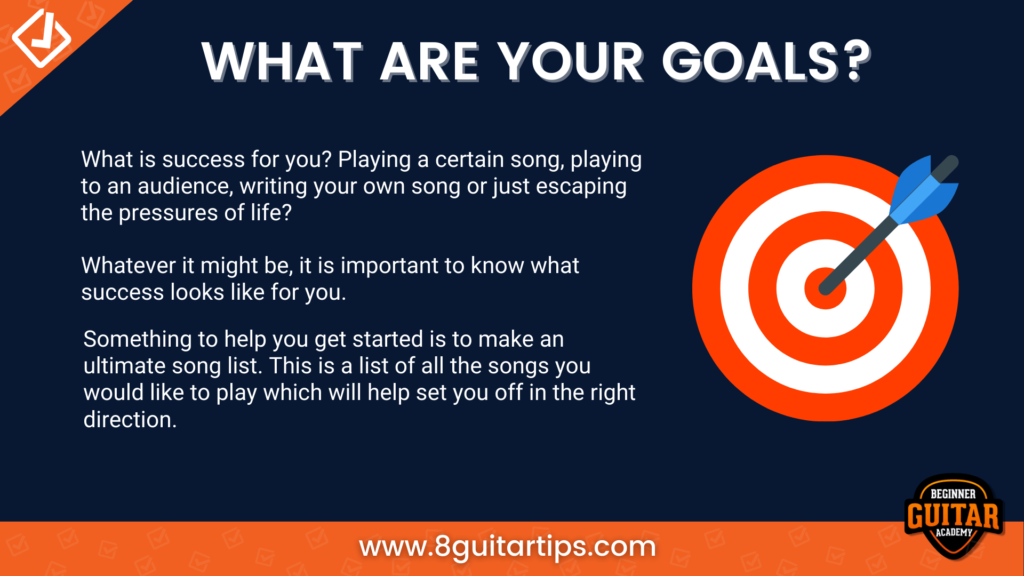
This could be as simple as you just want to play a few of your favourite songs or have something to help you unwind after a long day at work. Perhaps you want to join your friends at their next open mic night or play a song to your partner on your fiftieth wedding anniversary.
Whatever your goals are, it’s going to be very personal to you. Whatever it is, it is important to get clear on it now as it will help us shape your practice routine.
Next, I want you to create an ultimate song list. Now, this is as simple as listing the songs you’d like to be able to play. You could just use a piece of paper divided into two columns, one column for the song name and the other for the artist’s name.
Write down all the songs you’d like to be able to play and don’t be put off if you think they are too hard. Maybe you want to play Stairway to Heaven or a Steve Vai track for instance, both of which will take a few years to get up to that level you need to be to tackle them.
Just remember, the ultimate song list is for long term goals as well as a short term goals so it is good to have a mix of easy and hard songs to aim for.
Songs vs Skills
Next, I want to talk about songs vs skills. There’s a lot of guitar players that only push songs and there are other guitar players that only push skills. Now, there is value in both and ideally we want to learn both.
A good practice routine needs a balance of both, too much focus on songs and progress will be slow but too much focus on skills and practice with be dull.
We all first picked up the guitar because we wanted to be able to play songs but skills make up the songs, so if you can’t perform skills to a very good level, you’re not going to play songs very well.
Also having a good grasp of the skills means you will be able to assess your current skill level which will help you to pick suitable songs to learn. A lot of beginners fall into the trap of picking songs which are too difficult because they don’t know the different skills that make up that song and can’t asses the difficulty which results in frustration and loss of motivation.
The 7 Essential Guitar Skills
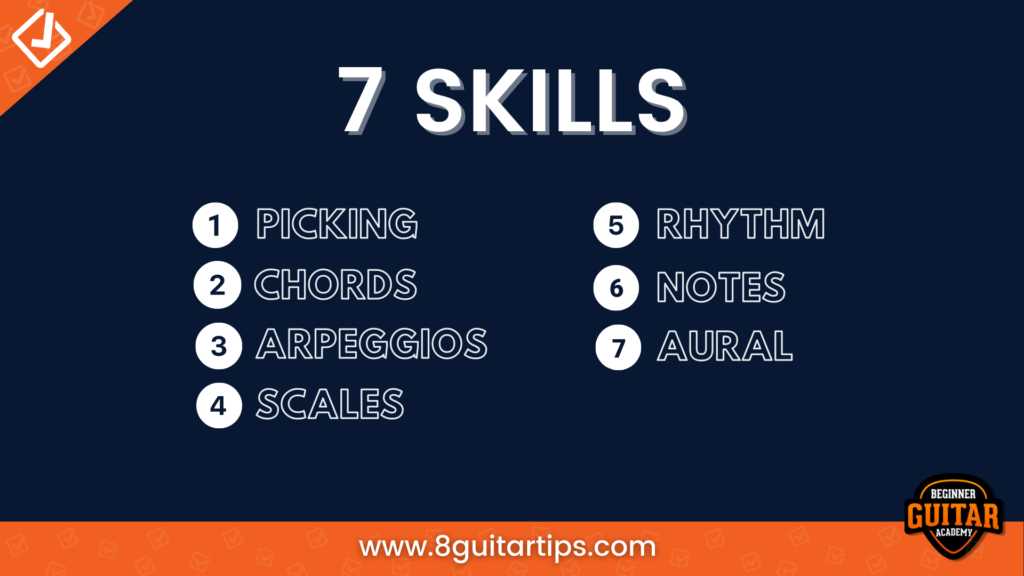
So now we know skills are important but what skills should you practice? Well, there are seven essential skills we teach at Beginner Guitar Academy which are picking, chords, arpeggios, scales, rhythm, notes and aural.
Now, I imagine some of these you have probably heard of and others you probably don’t know and I imagine you’re currently not practicing all seven of these, very rarely do I find a guitar player that does.
Many beginners just focus on chords and strumming because that’s the main thing you see when you look on the internet.
Now, something I always tell my students is to think about a footballer… a footballer wants to play matches right because that’s the fun thing to do, much like songs are the fun thing for us. However, the majority of a football players time is not spent playing matches, it’s spent practicing the skills so when they do end up playing a match they can perform to the best of their ability.
As a guitarist we want to spend most of our practice time practicing the seven skills so that when we play songs, we can learn them faster and perform them better.
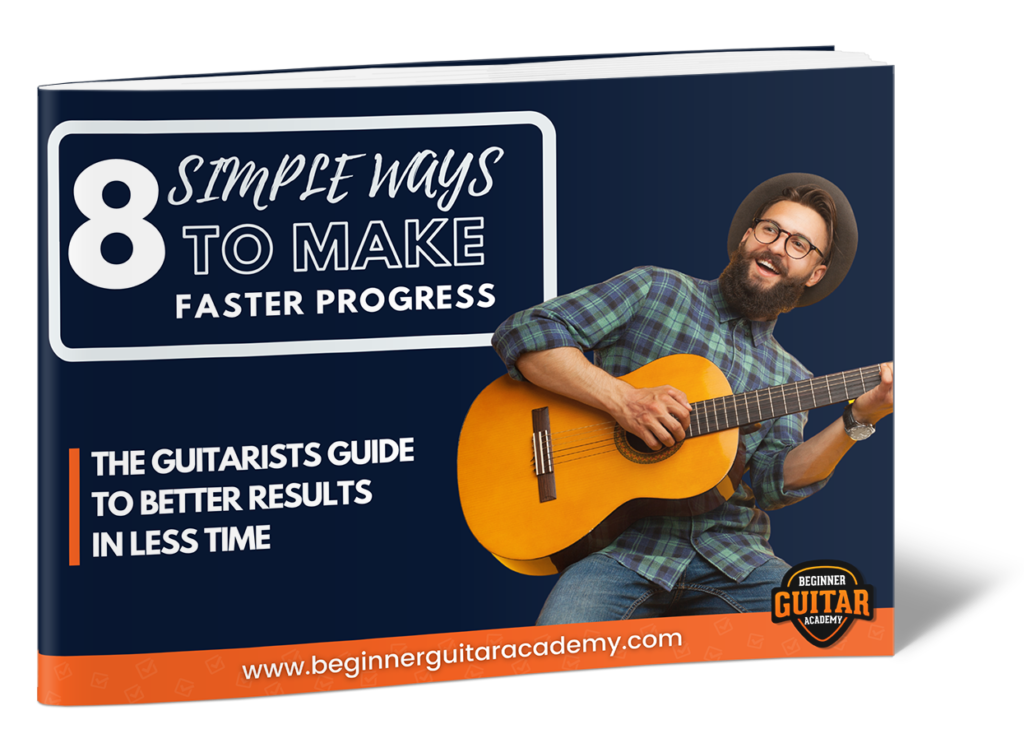
Free Download
8 simple tried and tested tips to help you make faster progress and hit your goals.
Practice Routines
So, now we have a bit more of an understanding about what should go into our practice routine what does that actually look like in a 30 minute routine?
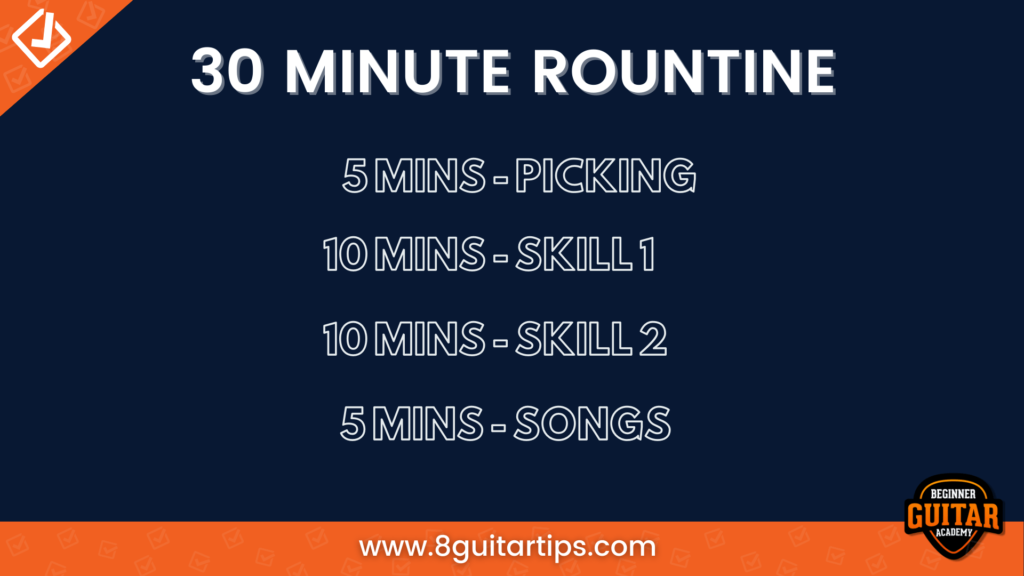
As you can see we first start with five minutes of picking, the reason for starting with picking is because as a beginner, you want to spend a fair bit of time on your picking hand.
Your picking hand is like the engine, it drives your guitar playing. I see a lot of beginners being held back because they have not spent enough time on their picking hand. As a result, they end up looking backwards and forwards between the two hands because they haven’t got the coordination dialled in and end up hitting the wrong strings more than the right ones.
Next, in our routine we have skill one for ten minutes and then skill two for 10 minutes. You can just pick the skills from the seven essential skills. You can choose whichever you like; chords, rhythm, aural, arpeggios, notes, etc.
The idea is that everyday you practice, you rotate through the seven skills. For example, on a Monday you might do arpeggios and scales for your skills practice, then on Tuesday you might do chords and ear training.
The idea is that at the end of the week, you’ve practiced every one of your skills so you are developing all of your key skills and becoming an all around guitar player, not just focused on one or two skills like many beginners do.
Then we end the routine with a song, the song is like the dessert at the end of a meal. The worst we can do is start with a song because you will probably find you do not move on to anything else because the songs are the fun stuff, so why are we doing anything else if songs are the fun stuff? I hear you cry, well because it’s the skills that are going to make the songs easier remember, songs are just a collection of skills.
Next we have a twenty minute routine and you can see in the picture below I have just halved the time we spend on the two skills, to make everything 5 minutes.
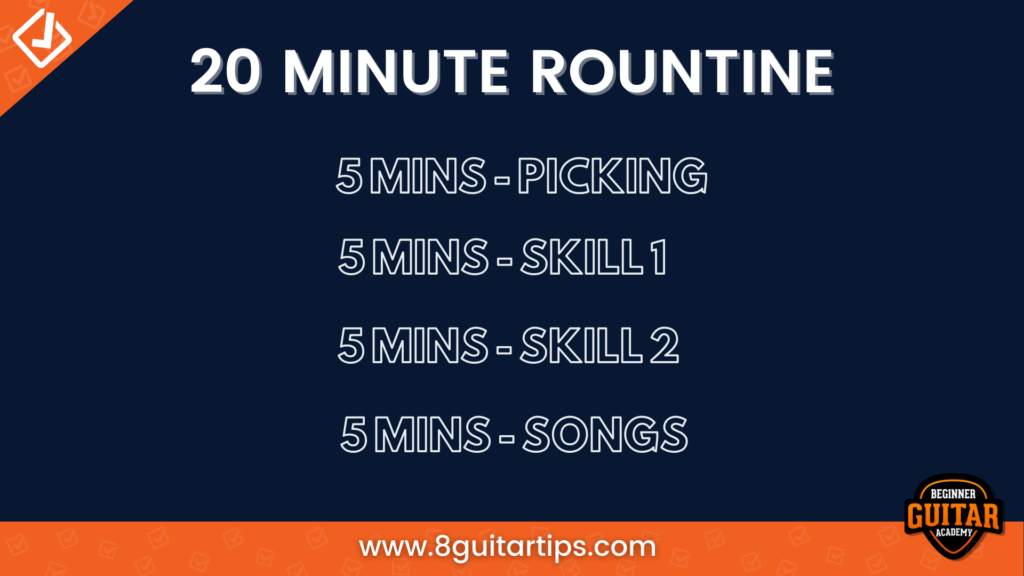
Lastly, I have done a ten minute routine where we spend two minutes on picking, three minutes on each of the two skills and two minutes on the song at the end.
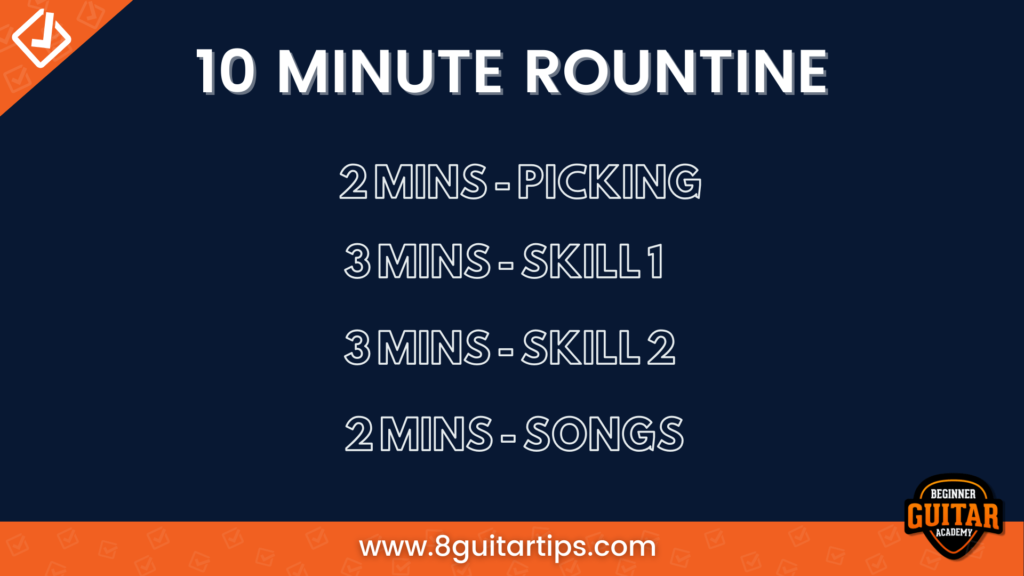
So there’s a thirty, a twenty and a ten minute routine. All three have the same four components; picking, skill one, skill two and a song. A routine like this is going to make your practice much more efficient and enable you to make faster progress towards your goals.
Just the right challenge
Just the right challenge is all about choosing something that is going to stretch you, but not break you. I see this a lot with beginners, they pick a song which is too challenging and it breaks them and they give up and then that’s the end of guitar.
I also see it where people just pick easy stuff to practice and just end up going around in circles and don’t progress beyond where they are because its too easy and not pushing them. The trick is to find the stretch zone where it is just the right challenge and that’s why it’s so important to follow a method, something that guides you step by step through what you should be doing.
Ideally, you want to find a method that’s been used with numerous students, that has been tried and tested. This is exactly what we’ve done at Beginner Guitar Academy. We use the G4 guitar method which I also use in my offline school where I teach a hundred students a week. There are fifty of us G4 teachers across the world using this method to teach thousands of students a week.
We have worked on this method over the last twenty years to make it the best method we can, so if you don’t know what to fill your practice routine with check out Beginner Guitar Academy and I will show you.
So now we know about skills vs songs, we have a template for a thirty, twenty, and ten practice routines. Next, we’ll dive in to more detail about what is actually going in to the different parts of the routine…

Free Download
8 simple tried and tested tips to help you make faster progress and hit your goals.
Example Routine
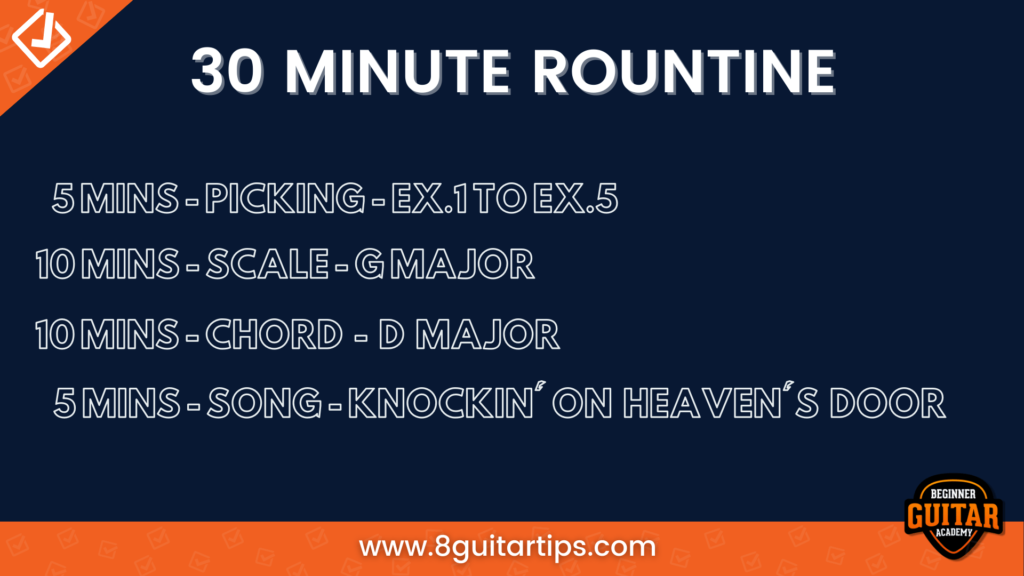
So now I am going to look a bit more in detail at the 30 minute practice routine. Firstly, we are going to start with picking and we’re going to do exercise one to exercise five, then for skill one we are going to do the G major scale and for skill two we are going to look at the D chord and finish with Knocking on Heaven’s Door.
This has actually been taken from class fourteen of our level one course. There are fifteen classes in total that take you through the whole of level one. In each class I guide you through the different parts of a perfect practice routine step by step.
Let’s now focus on each section of the routine in turn.
Picking
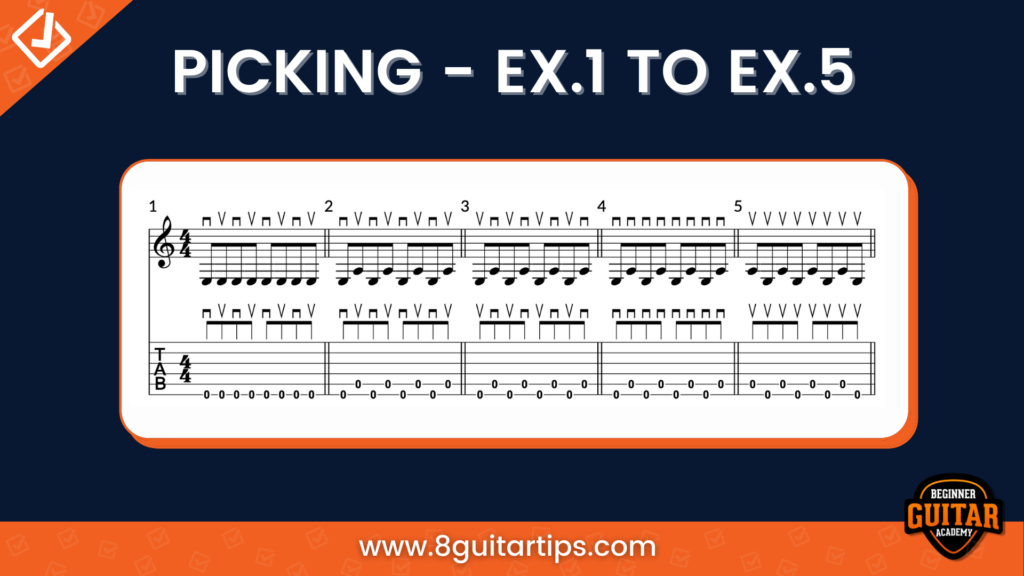
Firstly, we have picking where we do exercise 1 to exercise 5. Picking exercise one is just picking down then up on string six, this is called alternate picking. In exercises two we have outside picking, where we pick the outside of strings 6 and the outside of string 5.
Picking exercise three is called inside picking because we are picking the inside of string six and the inside of string five. In exercise four we’ve got just the same direction twice where we play two downs and for exercise 5 we have two downs. The importance of these five exercises is that you are going to find them in basically any song you want to play.
So, for instance, let’s take Walk this Way by Aerosmith, it starts with picking exercise one followed by picking exercise two. If I have practiced these exercise enough, this is going to be pretty easily and you will find your picking hand will just go on autopilot and away you go.
If we then take a look at the fretting hand all it is doing is playing notes from the E blue scale. So if we have get these skills in place, it makes learning songs so much easier.
There is picking in a little bit more detail so next we are going to take a look at the skill one, the G scale.
Scale – G Major
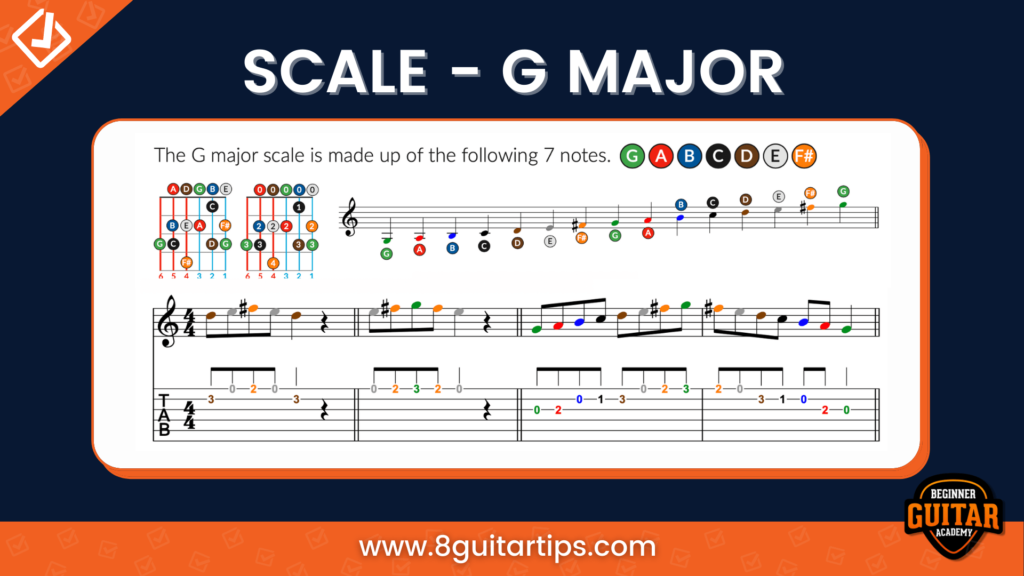
A trap a lot of people fall into when they are learning a scale is they try to learn the whole scale all at once. That is fifteen notes to learn which is just too many to remember without lots of repetition. A much more efficient way to practice is to break the scale down into smaller bite sized chunks and build it up slowly.
If you look in the picture below you can see the first exercise only has five notes in it and as we progress through the exercises we gradually build up the notes making learning the scale easier and much quicker. By breaking the scale down into smaller chunks you can also focus on technique and make sure you are playing correctly.
So there’s our scale, now on to the skill two the D chord.
Chord – D Major
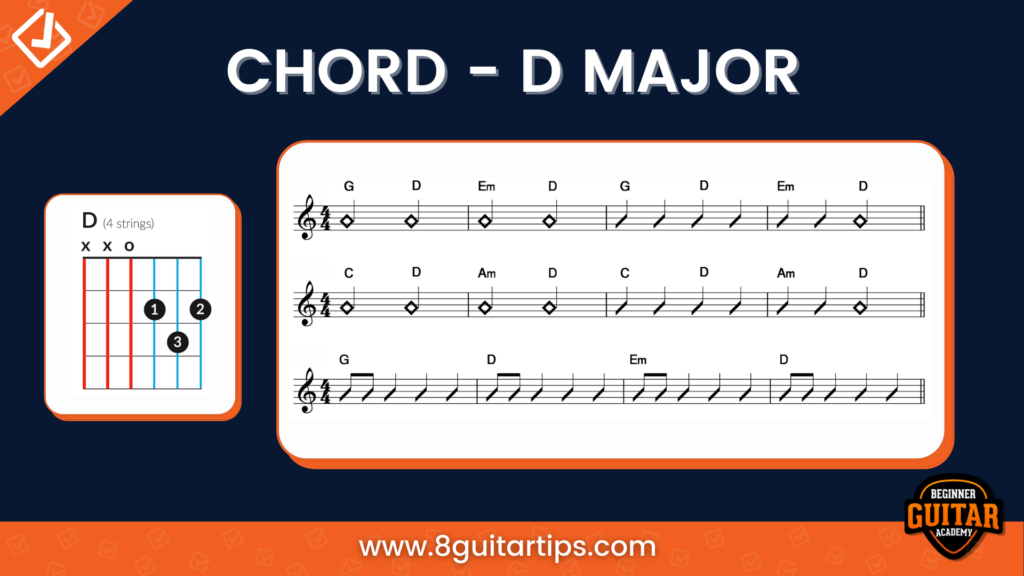
When it comes to chords I teach the three S’s which are Shape, Sound and Speed. So first we work on the shape and by that I mean just focusing on the left hand which involves taking the shape off the strings and placing it back down again, being careful to play the correct shape each time.
The next thing to work on is the sound, this is where we bring in the right hand and pick through the chord, checking the sound of the individual strings.
Pick each string one at a time and make sure each note sounds clear with no buzzing, if the note is not sounding clear or has buzzing, make sure you are pushing down with the very tip of your finger and that your finger is positioned close to the metal wire and not touching adjacent strings.
Now that we have got the shape and have got a good sound it’s time to move on to the next step, which is speed and by this I mean changing to other chords. That’s where the exercises in the picture come in.
As you can see, we’re now combining skills, we’ve got the chord shape with the left hand and the strumming with the right hand. The trick to really mastering chord speed is to first nail each skill by themselves in isolation, then start combining them once you are happy to.
Song – Knockin’ On Heaven’s Door
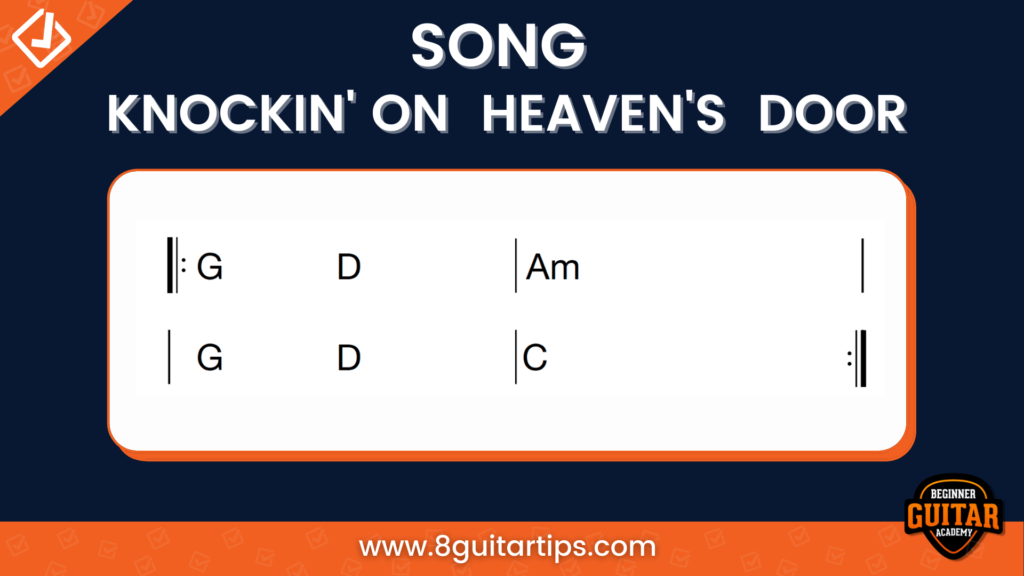
For the last few minutes of our practice routine we are going to finish with a song, Knockin’ on Heaven’s door to be exact, this is where all the skills come together. The song uses all the chords we were practicing earlier, so we should be ready to tackle it.
This is the great thing about practicing skills, when it comes time to play the song, you’ll find you will be able to learn the song a lot quicker because you’ve put in the hard work beforehand in the skills section of the routine.
Also Knockin’ on Heaven’s Door is in the key of G major so we can use the scale we were practicing earlier as well. We can use notes from the G major scale to play the tune of the song. You could even use the scale to make up a solo to play over the top of the song.
So as you can see, everything we practiced throughout the practice routine is coming together in the song at the end, the chords, the scale, it all kind of wraps up together at the end. That’s the idea, the skills, feed it to the song.
Action plan
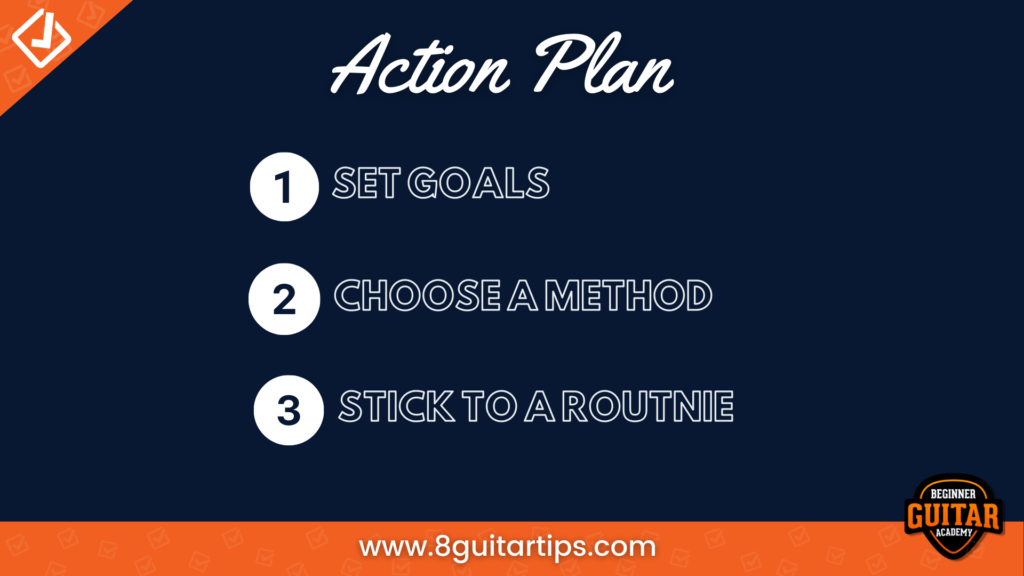
So now hopefully we have an idea of how to practice and what a good guitar practice routine looks like. I want to leave you with a three step action plan. Firstly set your goal, why do you want to be playing in the first place? Then write out your ultimate song list.
Step two choose a method and make sure it is something that is structured and is going to stretch you but not break you, this is going to help you progress a lot quicker.
Finally step three, stick to a routine 30, 20 or 10 minutes whatever you can. Set some time in your diary and try and do it as many days as you can. If you can practice every day fantastic but even if you are able to do three or so days a week that is still good and by following a practice routine like we went through you will make good progress.
The last thing I want to encourage you to do is to pick up my free ‘8 simple ways to make faster progress’ guitarists guide. It includes eight tips that will really help you make faster progress, I have also just added a series of videos to accompany the guide where I go into more depth for each of the tips, so make sure you click below to download it.
If you have any questions just drop them in the comments below.




